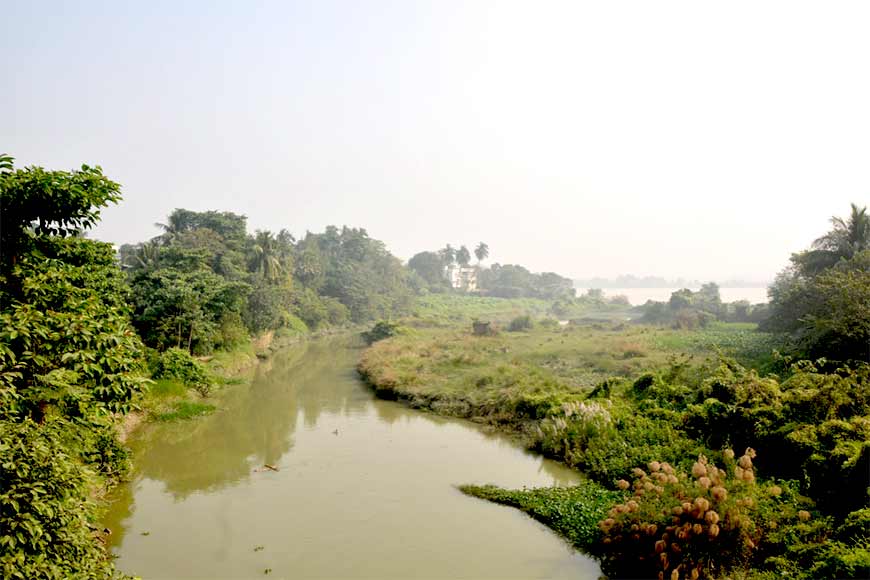On World Rivers Day, in search of the missing Saraswati River of Bengal. Did it exist?

“Rivers are the arteries of our planet; they are lifelines in the truest sense.”
The Indian subcontinent was the scene of dramatic upheavals a few thousand years ago. The Northwest region entered an arid phase, and erosion coupled with tectonic movements played havoc with river courses and one of them, the Sarasvati River, simply disappeared! The Sarasvati River played an important role in the Vedas.
Drishadvati river is a river hypothesized by Indologists to identify the route of the Vedic river Sarasvati and the state of Brahmavarta. In the Manu Smriti, the Drishadwati and the Sarasvati define the boundaries of the Vedic state of Brahmavarta, the land, created by the Gods, which lies between the two divine rivers Sarasvati and Drishadvati. The text also mentions the Sarasvati formed the northern boundary of Kuru Pradesh and the Drishadwati flowed in the south. Several Puranas describe the Sarasvati River separated into a number of lakes (saras). The Mahabharata mentions Balaram undertaking a journey along the banks of the Sarasvati from Dwarka to Mathura. There were ancient kingdoms too (the era of the Mahajanapads) that lay in parts of north Rajasthan and that were named on the Sarasvati River.
 There was however, another Saraswati River in the eastern part of India as a distributary of the Bhagirathi and probably was active till around the 16th century AD. Once a vibrant water body, the Saraswati River of Bengal has decayed due to both natural and human factors. The course and condition of the Saraswati played a crucial role in the development and decline of river port towns, particularly the port town of Tamralipta. It is believed that the Saraswati flowed into an estuary near present-day Tamluk in East Midnapore district and received the waters of not only the Rupnarayan and Damodar, but several other smaller streams. Sometimes after the 8th-century AD, Tamralipta lost its importance primarily on account of silting up of the mouth of Saraswati and the consequent shifting of its course.
There was however, another Saraswati River in the eastern part of India as a distributary of the Bhagirathi and probably was active till around the 16th century AD. Once a vibrant water body, the Saraswati River of Bengal has decayed due to both natural and human factors. The course and condition of the Saraswati played a crucial role in the development and decline of river port towns, particularly the port town of Tamralipta. It is believed that the Saraswati flowed into an estuary near present-day Tamluk in East Midnapore district and received the waters of not only the Rupnarayan and Damodar, but several other smaller streams. Sometimes after the 8th-century AD, Tamralipta lost its importance primarily on account of silting up of the mouth of Saraswati and the consequent shifting of its course.
After the decline of Tamralipta port, Saptagram (colloquially called Satgaon) emerged as a major port, the chief city and sometimes capital of southern Bengal, in ancient and medieval times. It was in the present-day Hooghly district. At Tribeni near Bandel, the Bhagirathi River branched off into three streams. The Saraswati flowed south-west beyond Saptagram, the Jamuna (this is distinct from the river of the same name in northern India and several streams of the same name in Bangladesh) flowed south-east, past the northern boundary of present-day town of Kalyani and the Bhagirathi proper flowed through the present Hooghly channel to Kolkata and then through Adi Ganga to the Bay of Bengal.
But by the early 20th century, Saptagram port had dwindled to a group of insignificant huts. The port had to be abandoned because of the silting up and consequent drying of the Saraswati. It influenced the subsequent development and growth of Kolkata. In the 16th-century, the main waters of the Bhagirathi, which earlier used to flow through the Saraswati, started flowing through the Hooghly channel. In the course of time, the upper Saraswati dried up, but the Bhagirathi or Hooghly has abandoned the old Adi Ganga channel and flows through the lower course of the Saraswati below Sankrail.
 There is a clear indication of the river in Van den Brouck’s map of 1660. Almost 150 years prior to Van den Brouck’s map, Bengali poet Bipradas Pipilai wrote a beautiful account of the river and the surrounding area in his Manasamangal. As the merchant ship of the trader Chand Sadagar proceeded to the sea, he passed through the tri-junction (Triveni ) of the Ganga, Saraswati and Yamuna and Saptagram and. He wrote:
There is a clear indication of the river in Van den Brouck’s map of 1660. Almost 150 years prior to Van den Brouck’s map, Bengali poet Bipradas Pipilai wrote a beautiful account of the river and the surrounding area in his Manasamangal. As the merchant ship of the trader Chand Sadagar proceeded to the sea, he passed through the tri-junction (Triveni ) of the Ganga, Saraswati and Yamuna and Saptagram and. He wrote:
Gongo ar Soroshati, Jomuna bishal oti (The Ganga and Saraswati, the Jamuna are all so large)
The protection of water resources is core to the concept of sustainable development. The socioeconomic development of a country must be accompanied by environmental protection, so that the needs of the future are not compromised. The ‘death’ of a vivacious lively river like Saraswati that changed the fates of Tamralipta and Saptagram should be a reminder for all of us on World Rivers Day today and we should strive to take care and protect our rivers for a secure future of this world.










